The guarded, the cautious, the small-scale, the modest, the well-crafted—such books may be rewarded (in our own time, at the national level), but they are rarely preserved. They are not preserved because guardedness, caution, smallness, modesty, and craft can be replaced in any given generation. What is irreplaceable is excess: Of verbal kinesis, religious intensity, intellectual voracity.
Amit Majmudar on Entertainment and Excess: The Great Literary Audiences.
Amit Majmudar is talking about literature and posterity but his argument can be applied to other forms of art. I find the thesis a persuasive one, especially where novels are concerned, for the way it accounts for those works that manage to survive even when they offend the principles of craft and taste by which most novels are judged and criticised. No one would ever claim William Hope Hodgson as a great prose stylist but the excesses of his imagination have ensured that his work remains in print a century after it was first published, while hundreds of “finer” contemporary writers are completely forgotten.
Octave Mirbeau’s The Torture Garden (1899) is excessive enough to have ensured that if the author’s other works are reprinted at all it’s because they follow in The Torture Garden‘s wake of notoriety. The moral purpose behind Mirbeau’s scenes of lingering death may have been overwhelmed by its reputation as a classic of erotic sadism, but we’re a long way from 50 Shades of Grey as is evident from these etchings by French artist Raphaël Freida (1877–1942). Given the content it’s surprising to find an illustrated edition at all, Freida’s volume being a limited one published in 1927. The book contained 11 illustrations of which 7 are shown here from two different sources. The impaled figure in the second plate was a surprise since it seems to have been borrowed by Philippe Druillet for one of his pages in his bande dessinée album Yragaël (1974). (See below.) Druillet, like Freida, is an artist whose work is sufficiently excessive to prove attractive to future generations of comic readers and art enthusiasts.
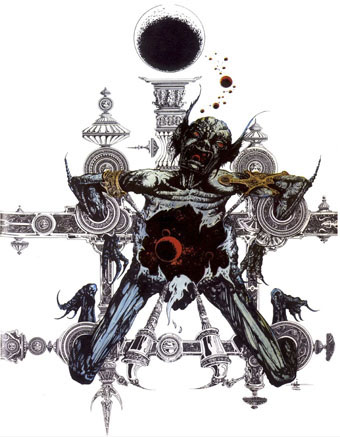
Elsewhere on { feuilleton }
• The illustrators archive
Previously on { feuilleton }
• The Garden of Adompha
• The art of Raphaël Freida

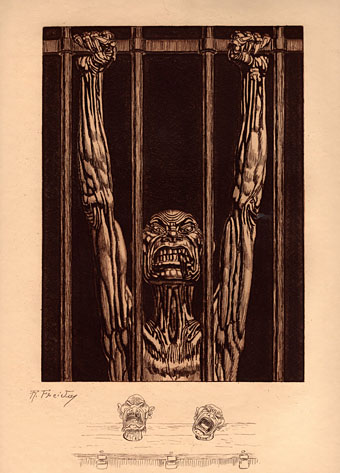
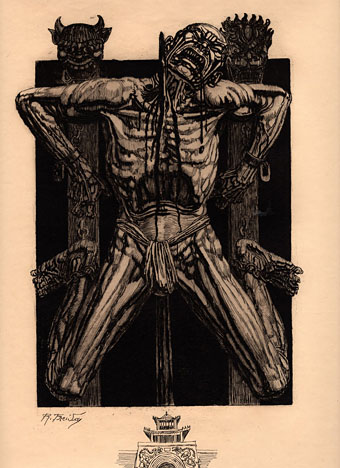
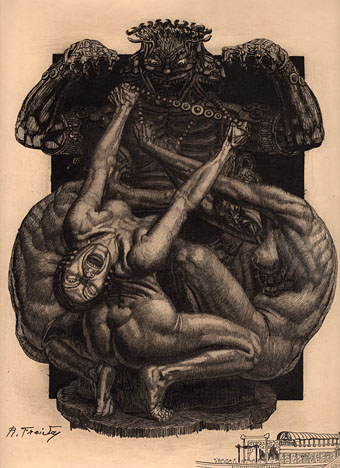
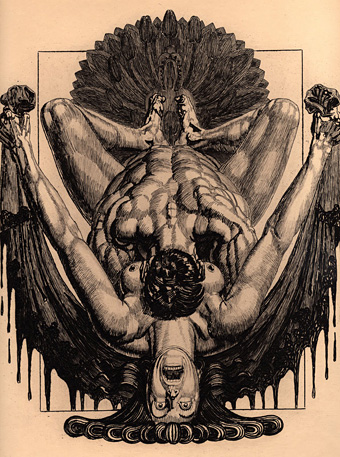
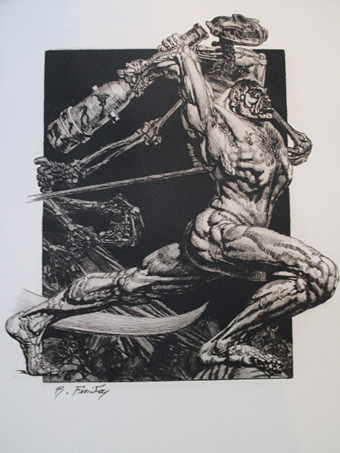
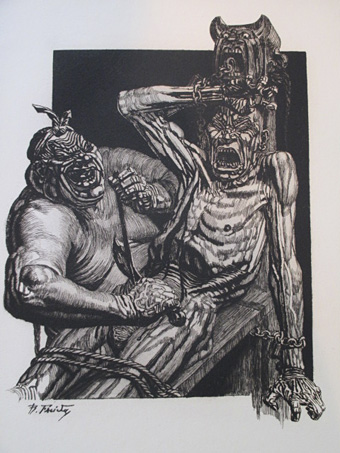
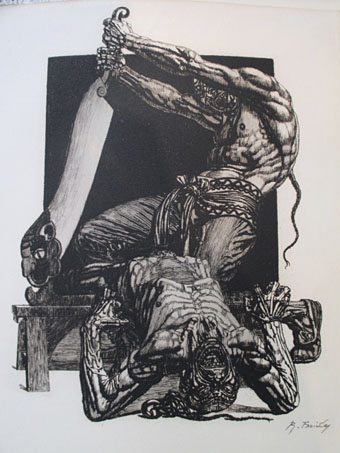
Grotesque, yes. But powerful.
Thanks for sharing!
it seems to have been borrowed by Philippe Druillet for one of his pages in his bande dessinée album Yragaël (1974).
Well-spotted that man.
These seem very literal illustrations. Maybe it was just me, but reading “Torture Garden” I saw it as a criticism of French colonial policy, and an implication that cruelty and sadism are universal human qualities — not confined to exotic cultures. Using exoticism and Orientalism to cast a cold eye on the French bourgeoisie. I don’t get that sense from the art-work, dramatic though it is.
Yes, that’s Mirbeau’s intent but the book is one of those curious works that publishers continually misrepresent. Goodreads is a useful guide to seeing the amount of times it’s been sold as a racy S&M title:
http://www.goodreads.com/work/editions/190495-le-jardin-des-supplices
Even Dedalus, of all people, published an edition with a photo of Catherine Deneuve in Belle de Jour on the cover:
http://www.goodreads.com/book/show/870282.The_Torture_Garden
As I say above, it’s a surprise to find this book illustrated at all. I don’t imagine there are many other illustrated editions.
There are quite a few illustrated editions in French alone. It was very popular in view of its grotesque episodes which attracted the feverish imaginations of many illustrators. Don’t know about other language editions although it is interesting to note than an English 1968(?) edition titled “The garden of evil” omitted the first few chapters describing the endemic corruption of the bourgeosie to concentrate on the “nitty gritty” of the torture garden itself. But what flights of sadistic imagination follow! I would like to see even more illusrated editions! So saying, the Dedalus cover is truly awful – and not in a good way either!
The edition by juno books is illustrated, or perhaps they were doctored photographs. I can’t seem to find mine. They weren’t bad and certainly fit more so with the actual events than the Freida illustrations. That said, they hardly live up to the text.
In and of themselves, the Freida illustrations are quite nice. They’re almost like a more transgressive and less speculative version of Stanislav Szulkalski.
The edition by juno books is illustrated, or perhaps they were doctored photographs.
Izzat the same as the Re/Search edition, with the black-&-white photos (except for a tinted version on the cover), soft-focus or selectively blurred?
Re/Search still sells their edition:
http://www.researchpubs.com/shop/last-copies-hardback-only-the-torture-garden-by-octave-mirbeau-2/
Juno Books was Andrea Juno’s imprint after she left Re/Search. I don’t know if they did an edition as well. I remember looking at the Re/Search one when it came out and being surprised it wasn’t more intense considering they’d recently done the Modern Primitives book which certainly was an eye-opener at the time.
OK, maybe it was the Re/Search edition I had/have. I wish I knew where it was, I doubt I’d have pawned it off. It is one of the few novel-length pieces alongside Arabian Nightmare, works by Hodgson and a few others that I’d consider being worth re-reading. Often excursions into such primal territory are best rendered in brief glimpses in the form of short stories. Since such excess is, by its nature, beyond the horizon of a civilized mindset, I usually find the more lengthy explorations, at least with literature, very sterile-feeling and uninspired.